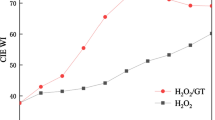Abstract
Pentaacetyl glucose (PAG) is a common and cheap intermediate and has biocompatible, nontoxic, and renewable features. PAG was investigated as a bleach activator for H2O2 in the pretreatment of gray knitting cotton fabric. The bleaching performance of the H2O2/PAG bleaching system was investigated by measuring the CIE whiteness index (WI), H2O2 decomposition rate and bursting strength. By addition of PAG, the WI and H2O2 decomposition rate increased significantly at 70 °C with little damage to the strength. The effects of temperature and pH value on WI were also considered. Due to its environmental advantages, the H2O2/PAG system showed a good applied prospect. By using benzenepentacarboxylic acid as a fluorescent probe for HO· detection, it was found that PAG could strongly promote HO· generation and that the concentration of HO· was closely related to the WI of the fabric. On this basis, a bleaching mechanism of the H2O2/PAG system was proposed.








Similar content being viewed by others
References
Baker IJA, Furlong DN, Grieser F, Drummond CJ (2000) Sugar fatty acid ester surfactants: base-catalyzed hydrolysis. J Surfactants Deterg 3:29–32
Bianchetti GO, Devlin CL, Seddon KR (2015) Bleaching systems in domestic laundry detergents: a review. RSC Adv 5(80):65365–65384
Cai JY, Evans DJ, Smith SM (2001) Bleaching of natural fibers with TAED and NOBS activated peroxide systems. AATCC Rev 1:31–34
Eren HA, Avinc O, Erişmiş B, Eren S (2014) Ultrasound-assisted ozone bleaching of cotton. Cellulose 21(6):4643–4658
Farrán A, Cai C, Sandoval M, Xu Y, Liu J, Hernáiz MJ, Linhardt RJ (2015) Green solvents in carbohydrate chemistry: from raw materials to fine chemicals. Chem Rev 115(14):6811–6853
Fei X, Yao J, Du J, Sun C, Xiang Z, Xu C (2015) Analysis of factors affecting the performance of activated peroxide systems on bleaching of cotton fabric. Cellulose 22(2):1379–1388
Forsyth SA, MacFarlane DR, Thomson RJ, von Itzstein M (2002) Rapid, clean, and mild O-acetylation of alcohols and carbohydrates in an ionic liquid. Chem Commun 7:714–715
Hickman WS (2002) Peracetic acid and its use in fibre bleaching. Rev Prog Color Relat Top 32(1):13–27
Hofmann J, Just G, Pritzkow W, Schmidt H (1992) Bleaching activators and the mechanism of bleaching activation. J Prak Chem Chem Ztg 334(4):293–297
Janicot I, Bouchu A, Descotes G, Wong E (1996) Correlation structure-activity in the bleaching properties of peracetylated carbohydrates. Tenside Surfactants Deterg 33:290–296
Jegannathan KR, Nielsen PH (2013) Environmental assessment of enzyme use in industrial production—a literature review. J Clean Prod 42:228–240
Lee J, Hinks D, Lim S-H, Hauser P (2010) Hydrolytic stability of a series of lactam-based cationic bleach activators and their impact on cellulose peroxide bleaching. Cellulose 17(3):671–678
Long X, Xu C, Du J, Fu S (2013) The TAED/H2O2/NaHCO3 system as an approach to low-temperature and near-neutral pH bleaching of cotton. Carbohydr Polym 95(1):107–113
Luo X, Sui X, Yao J, Fei X, Du J, Sun C, Xiang Z, Xu C, Wang S (2015) Performance modelling of the TBCC-activated peroxide system for low-temperature bleaching of cotton using response surface methodology. Cellulose 22(5):3491–3499
Ma S-L, Wu Y-T, Hurrey ML, Wallen SL, Grant CS (2010) Sugar acetates as CO2-philes: molecular interactions and structure aspects from absorption measurement using quartz crystal microbalance. J Phys Chem B 114(11):3809–3817
Milne NJ (1998) Oxygen bleaching systems in domestic laundry. J Surfactants Deterg 1(2):253–261
Reinhardt G, Borchers G (2008) Application of bleaching detergent formulations. In: Zoller U (ed) Handbook of detergents, part E: applications. CRC, New York, pp 375–418
Ren L, Kim HK, Zhong W (2009) Capillary electrophoresis-assisted identification of peroxyl radical generated by single-walled carbon nanotubes in a cell-free system. Anal Chem 81(13):5510–5516
Santra A, Guchhait G, Misra AK (2011) Efficient acylation and sulfation of carbohydrates using sulfamic acid, a mild, eco-friendly catalyst under organic solvent-free conditions. Green Chem 13(5):1345–1351
Shaw J-F, Klibanov AM (1987) Preparation of various glucose esters via lipase-catalyzed hydrolysis of glucose pentaacetate. Biotechnol Bioeng 29:648–651
Si F, Yan K, Zhang X (2014a) Study on H2O2/TAED and H2O2/TBCC bleaching mechanism related to hydroxyl radical with a fluorescent probe. Carbohydr Polym 103:581–586
Si F, Zhang X, Yan K (2014b) The quantitative detection of HO˙ generated in a high temperature H2O2 bleaching system with a novel fluorescent probe benzenepentacarboxylic acid. RSC Adv 4(12):5860–5866
Smith MB (ed) (2010) Chapter 7 protecting groups. In: Organic synthesis, 3rd edn. Academic, Oxford, pp 587–622
Wang S, Li S, Zhu Q, Yang CQ (2014) A novel low temperature approach for simultaneous scouring and bleaching of knitted cotton fabric at 60 °C. Ind Eng Chem Res 53(24):9985–9991
Xu C, Long X, Du J, Fu S (2013) A critical reinvestigation of the TAED-activated peroxide system for low-temperature bleaching of cotton. Carbohydr Polym 92(1):249–253
Acknowledgments
The authors gratefully acknowledge Dr. Chunyan Hu for the experimental equipments and Bolin Ji for statistical analyses.
Author information
Authors and Affiliations
Corresponding authors
Rights and permissions
About this article
Cite this article
Liu, K., Zhang, X. & Yan, K. Low-temperature bleaching of cotton knitting fabric with H2O2/PAG system. Cellulose 24, 1555–1561 (2017). https://doi.org/10.1007/s10570-016-1167-8
Received:
Accepted:
Published:
Issue Date:
DOI: https://doi.org/10.1007/s10570-016-1167-8




